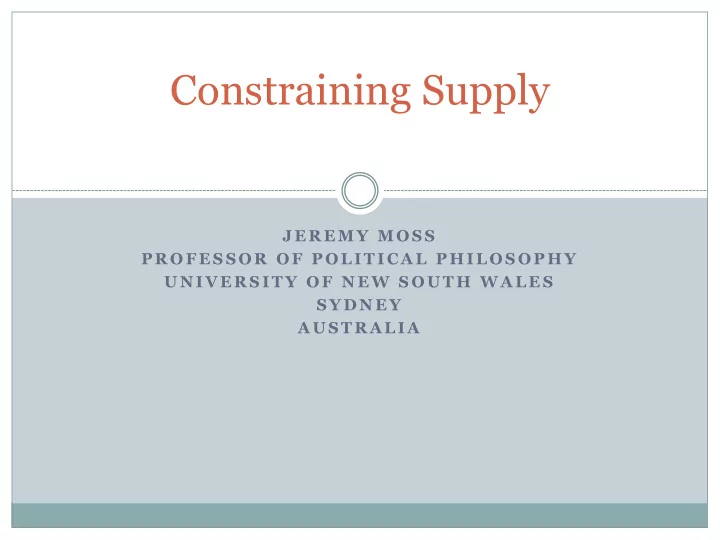

Constraining Supply J E R E M Y M O S S P R O F E S S O R O F P O L I T I C A L P H I L O S O P H Y U N I V E R S I T Y O F N E W S O U T H W A L E S S Y D N E Y A U S T R A L I A
Claim Current and likely future methods for dividing emissions inadequate. We should count ‘exported emissions’. Prima Facie case for: carbon budget moral responsibility for consequences responsibility for scope 3 emissions
Analogy with other commodities Analogies: Tobacco Medical waste Uranium Claim : “We should not knowingly contribute to situations that harms the significant interests of others where we can avoid doing so.” Causing harm to the significant interests of others should provide a powerful and important constraint on our actions. Consequences: morally responsibility Cease causing harm
Supply-side policy Demand-side policy Economic instruments – Resource production tax Carbon or fuel use taxes taxes Resource export taxes Border carbon price adjustments Taxes on fossil fuel capital (income) Removal of fossil fuel consumer Economic instruments – subsidies Removal of fossil fuel producer subsidies subsidies Renewable energy subsidies Economic Cap-and-trade for consumption rights instruments – tradable Cap-and-trade for production rights Offsets for leaving assets in Emission reduction credits or offsets allowances and credits ground Prohibiting development of certain resources or use of certain technologies Limiting production or export (e.g. via quota) Coal plant emission standards Building codes Regulatory Comprehensive emissions assessment in environmental impact review of approaches new fossil fuel supply projects Restricted leasing of state-owned lands and waters for coal, oil and gas development. Decision to not develop specific resources or infrastructure (oil pipelines Infrastructure expansion (district heating / cooling; electric and terminals; coal ports, etc.) vehicle charging station; wind transmission) Government provision Funding to compensate resource owners for leaving reserves of goods and services Policies to restrict export credit agency or multilateral undeveloped development finance for coal power stations Policies to restrict export credit agency or multilateral development finance for coal mining and other supply infrastructure Divestment by institutions and individual from companies involved in fossil fuel production Information Energy audits programmes, voluntary Extraction-based emissions accounting by nations and sub-national Vehicle or appliance labelling Territorial emissions governments; life-cycle based accounting of embedded GHGs in fossil actions, and other fuels sold in marketplace accounting
Economic They can have lower administrative costs than demand side policies such as cap and trade or carbon taxes Avoids lock in of infrastructure (pipelines, ports etc) Might avoid ‘Green paradox’, where anticipation of a future carbon tax leads to increased short term production of fossil fuels.
Political benefits Perceived to be fair (green). Typical climate policies are their effects are directed at disparate people and over varying degrees of time. Targetting actual fuels, evidence suggests, this gives people a more immediate sense of their effectiveness is more likely to be supported. Overcome the distortions that stem from territorial bias in emissions counting Addressing the problem of the over supply of fossil fuels, which might in turn produce lock in effects They might increase public support by targeting the right actors – political acceptance of action on CC.
Moral advantages Best reflects the injunction of the harm principle Ranking supply side constraints Exporters Targeting the right agents
Recommend
More recommend